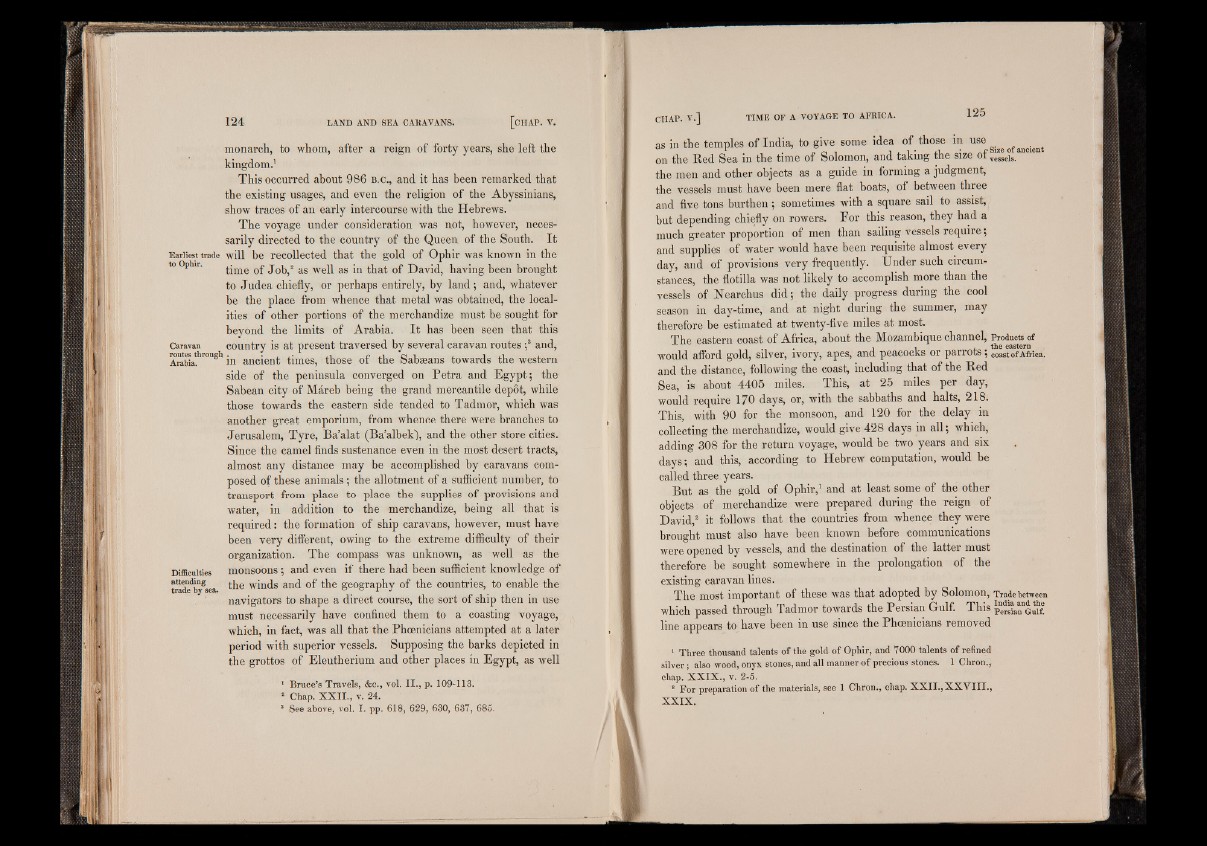
monarch, to whom, after a reign of forty years, she left the
kingdom.1
This occurred about 986 B.C., and it has been remarked that
the existing usages, and even the religion of the Abyssinians,
show traces of an early intercourse with the Hebrews.
The voyage under consideration was not, however, necessarily
directed to the country of the Queen of the South. It
Earliest trade will be recollected that the gold of Ophir was known in the
to Ophir. time of Job,2 as well as in that of David, having been brought
to Judea chiefly, or perhaps entirely, by land; and, whatever
be the place from whence that metal was obtained, the localities
of other portions of the merchandize must be sought for
beyond the limits of Arabia. It has been seen that this
Caravan country is at present traversed by several caravan routes ;3 and,
Arabia*™”8 in ancient times, those of the Sabseans towards the western
side of the peninsula converged on Petra and Egypt; the
Sabean city of Mareb being the grand mercantile depot, while
those towards the eastern side tended to Tadmor, which was
another great emporium, from whence there were branches to
Jerusalem, Tyre, Ba’alat (Ba’albek), and the other store cities.
Since the camel finds sustenance even in the most desert tracts,
almost any distance may be accomplished by caravans composed
of these animals; the allotment of a sufficient number, to
transport from place to place the supplies of provisions and
water, in addition to the merchandize, being all that is
required: the formation of ship caravans, however, must have
been very different, owing to the extreme difficulty of their
organization. The compass was unknown, as well as the
Difficulties monsoons; and even if there had been sufficient knowledge of
tradefby8sea w™ds and of the geography of the countries, to enable the
navigators to shape a direct course, the sort of ship then in use
must necessarily have confined them to a coasting voyage,
which, in fact, was all that the Phoenicians attempted at a later
period with superior vessels. Supposing the barks depicted in
the grottos of Eleutherium and other places in Egypt, as well
' Bruce’s Travels, &e., vol. I I ., p. 109-113.
2 Chap. X X I I ., v. 24.
3 See above, vol. I. pp. 618, 629, 630, 637, 685.
as in the temples of India, to give some idea of those in use a,o r i i i i • ui * ~ Size of ancient on the Eed Sea in the time of Solomon, and taking the size ot vesseis.
the men and other objects as a guide in forming a judgment,
the vessels must have been mere flat boats, of between three
and five tons burthen ; sometimes with a square sail to assist,
but depending chiefly on rowers. For this reason, they had a
much greater proportion of men than sailing vessels require ;
and supplies of water would have been requisite almost every
day, and of provisions very frequently. Under such circumstances,
the flotilla was not likely to accomplish more than the
vessels of Nearchus did; the daily progress during the cool
season in day-time, and at night during the summer, may
therefore be estimated at twenty-five miles at most.
The eastern coast of Africa, about the Mozambique channel, Products of
- . 1 , the eastern would afford gold, silver, ivory, apes, and peacocks or parrots} coast of Africa,
and the distance, following the coast, including that of the Bed
Sea, is about 4405 miles. This, at 25 miles per day,
would require 170 days, or, with the sabbaths and halts, 218.
This, with 90 for the monsoon, and 120 for the delay in
collecting the merchandize, would give 428 days in all; which,
adding 308 for the return voyage, would be two years and six
days; and this, according to Hebrew computation, would be
called three years.
But as the gold of Ophir,1 and at least some of the other
objects of merchandize were prepared during the reign of
David,2 it follows that the countries from whence they were
brought must also have been known before communications
were opened by vessels, and the destination of the latter must
therefore be sought somewhere in the prolongation of the
existing caravan lines.
The most important of these was that adopted by Solomon, Trade between
which passed through Tadmor towards the Persian Gulf. This
line appears to have been in use since the Phoenicians removed
1 Three thousand talents of the gold of Ophir, and 7000 talents of refined
silver; also wood, onyx stones, and all manner of precious stones. 1 Chron.,
chap. X X IX ., v. 2-5.
2 For preparation of the materials, see 1 Chron., chap. X X I I ., X X V I I I .,
X X IX .